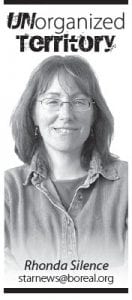When I became a newspaper editor 13 years ago, I was definitely an amateur. I have always been a writer and no matter what job I held, I managed to work myself into some sort of writing position—ad copy, newsletters, meeting minutes— I love putting words together in any way possible.
But when Publishers Hal and Deidre Kettunen hired me to serve as editor of the Cook County Star, I had practically no newspaper experience. I had been a freelancer for several years, but I had no clue how to put a paper together.
It was a challenge and the learning curve was really steep. It was terrifying and it was rewarding. My bible was the AP Stylebook—the Associated Press guide to everything newspaper.
I read the stylebook, as well as the Chicago Manual of Style and E.B. White’s The Elements of Style continuously. The texts were invaluable when I needed direction on what is capitalized and what isn’t; when numbers are spelled out and when they are not; when to say who and when to say whom; when to use a comma and when to use a semicolon and so on.
However, there was one rule that I disagreed with. I rebelled. As an amateur editor, I didn’t think it was sacrilege to stray from the style manual—especially if it makes things easier for our readers.
I decided to defy the style manual’s directive about dates in news articles. The AP Stylebook declares that we do not include the year in the date unless the date is not in the current year. For example, in an article in this paper, AP believes we should not state that a meeting was held on March 6, 2013 because it is the current year. If we were talking about March 6, 1883, the year should be included according to the Associated Press.
But apparently, the compilers of the AP Stylebook have never sorted through a box of news clippings to paste in a scrapbook, only to find that the date had been cut off the page. How do we know when the picture of grandpa with his record-setting fish was caught when it simply says March 6? Was that cute little Girl Scout selling cookies in March 1980 or 1981?
Even in the digital age, dates can be tricky. A news article may say there was a house fire on March 5, but the computer may register the date that the news was posted to the Internet or the date that you logged on to look at it. Confusion can reign as you try to determine whether the news event was this year or five years ago.
So, I include the full date—month, day, and year—in every article that I write. This is a glaring violation of AP standards, but I don’t care. It has saved me numerous times when I am doing some quick research in my document archives.
As any reader who follows our Down Memory Lane feature knows, the same news stories cycle through the decades. If all I have is the text of an article about the community center or the Economic Development Authority or the Fisherman’s Picnic, how do I know what year the discussion took place?
If I follow AP style, I don’t. So I don’t follow AP style.
I have however, always felt a little insecure about it. I wondered if I should overcome my bias and fall in line with the journalistic rules that have been in place for centuries.
I’ve been vindicated though, when researchers or historians come in, seeking more information on an old Cook County News-Herald article. People bring in a faded newspaper clipping, wanting more information. Maybe it is about an accident and they want to read the follow-up information. Perhaps it was about a school or sporting event announced on the snippet of paper and they want to learn more.
Without a date, it is nearly impossible to find that information. We have wonderful big binders full of old newspapers—but there is no search feature. To find an article in our old archives, you must look through them, page-by-page, week-by-week. If you don’t have an idea of the year it could take days to find what you are looking for.
Not so since I became editor. If you have an old issue of the Cook County Star or a copy of the News-Herald since 2008, the date will be right there in the news clipping that was clipped.
I was reminded of my defiance again this week when our designer Laurie’s mom sent her an interesting news clipping from her hometown paper. It was from sometime in Laurie’s growing up years and included her grandfather hard at work on his cattle ranch. Laurie’s mom was terribly irritated that whoever saved the clipping had carefully cut the text and the photo out, but .not the date.
As Laurie tried to calculate the year that the article must have been published I smugly thought how much simpler things would have been if the reporter had not followed AP style. Sometimes it’s okay to break the rules.
Never be afraid to try something new.
Remember the Ark was built by amateurs,
but professionals built the Titanic.
Richard Needham



Loading Comments